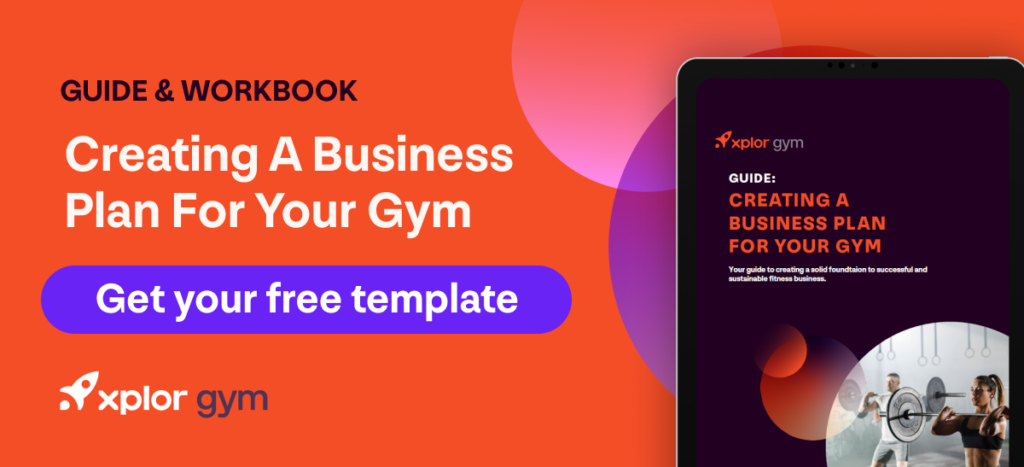A gym business plan is a key tool for any thriving business. In this how to guide, you’ll learn the benefits of having a fitness business plan and how to go about creating one for your gym.
Thinking about owning a gym? Looking to grow your existing business by opening a new site? Or want to think about the future of your fitness club?
Spending time on your gym business plan will help you thrive. And that’ll make it easier to attract a bigger share of the estimated $501.5 million in revenue the New Zealand fitness industry attracts.
Think of your business plan as a tool you can actively use to guide your journey as a gym owner. It’ll help you make informed decisions. And can even help you attract investors and top management talent to your business.
We know that creating a business plan for your gym can be a daunting task. So, we’ve created this how to guide to help you create a winning fitness business plan.
Find out all about the ways your gym business plan can help you. How to write an impactful one. And get details of what to cover in each section. No guess work needed!
Let’s get stuck in!
A supportive partner for your club
With the right gym management software in place, you’ll be perfectly positioned to work on your business more. Less admin, more time to grow your business.
What is a gym business plan?
A gym business plan is a written document that describes your business. This strategic document will outline your company’s goals. Detail strategies for achieving them.
It’ll cover:
- The purpose and mission of your business
- Specific goals
- The market you’re operating in
- Your go-to-market approach
- How your business is structured and operates
- What you have to offer
- Financials
- And more!

Why do I need a fitness business plan?
Good question! Your fitness business plan is so much more than a way to attract funding to your business. It’ll help you:
- Articulate your business idea/what your existing business is all about
- Spot potential problems
- Record your business goals
- Plan and evaluate new ideas and growth plan
- Measure progress
Think through what you’re doing
Working on a gym business plan will help you think through your business. You’ll create a strategy and action plan for the next 1-3 years. It’s a chance to set goals and objectives and plan how to achieve them.
The writing process will help you focus and develop your ideas. If you have a team, get them involved in your planning process to get their buy-in and build commitment.
Think about priorities to optimise your time. It’ll make it easier to spot gaps that you need to work through ahead of time. And once you have your plan, you’ll be able to use it as a benchmark when measuring business performance.
Explain your business to others
Looking to raise new finance? Have existing investors? Want to attract top talent and partners to your business? A gym business plan can help.
Tailor your plan to the target audience you’re aiming it to. Address specific questions they might have and follow the template they’d expect to see. For example, if you’re looking to attract finance from a bank, you’ll need to make sure the plan meets their requirements.
Achieve your goals
Your business plan will help set your gym up for success when it comes to achieving short, medium and long-term goals. It’ll outline how you’re going to achieve your goals, allowing you to think through what you’ll need to do and steps to take.
And as your goals evolve, you’ll be able to revisit your business plan to make updates as needed. Think of your gym business plan as a continual work in progress to develop and refine.

How do I write business plan for my gym?
Before we get stuck in to how to write your gym business plan, let’s look at what you need to consider during the writing process:
Remember quality over quantity wins every time!
Think about what your reader actually needs to know. What will they care about? Your business plan should focus on delivering quality without waffle. Even the most comprehensive plan is usually 20-30 pages at the most.
Your plan should provide a clear roadmap for your business. One that’s short enough to hold the reader’s attention while effectively communicating what you need them to know.
Have extra info you want to add? Include an appendix at the end of your plan. This is the ideal place to provide detailed info like:
- Financial forecasts
- Market research data
- CVs of key team members
- And technical details of your offering
Keep it short and sweet for the win!
Choose a useful format
Above all, your gym business plan should be something you use to run your business. And that usually means it shouldn’t be too long!
When choosing a format think about how you’ll best be able to express your views in a way that excites and inspires you towards success. Consider formats that will be easy to share with others too. Digital documents are usually best here.
Make sure you format your plan professionally so it’s easy for others to use too. That means:
- Adding a cover page
- Using sections, adding page numbers, and including a contents page to help readers find their way around
- Choosing a clean, professional font (hint: avoid Comic Sans😂) and using consistent styles and sizes throughout
- Add graphs and charts to bring data to life
Be a realist
When writing a gym business plan, it’s easy to be over-optimistic – especially when you’re passionate about your gym. Financial projections are a particular area to make sure you’re not being a little too optimistic in.
Make sure you’re being realistic about what’s achievable given the findings in your plan. This will also help you keep your overheads lean and avoid the need to cut costs further down the line.
Being a realistic is especially important if you’re creating your business plan with a view to attract investment, funding, or a sale. Third parties can normally see through over-optimistic projections and assumptions. Failing to be a realist could hit your credibility as a business person.
Review, review, review
Before sharing your fitness business plan with your intended readers, take time to review it thoroughly.
Put yourself in the shoes of your reader – are you covering what will matter to them. Include evidence to support any claims you’ve included to build credibility (add these to the appendix).
Check for typos and spelling mistakes. Use the review tools in the software you’ve used to create your plan to check for grammatical errors. And read it aloud to make sure everything flows nicely.
Share your gym business plan with your friends, peers, and trusted partners. Ask for honest feedback. Don’t take feedback personally, consider objectively how you can use it to enhance your plan.

How to write a gym business plan in 9 steps
As we’ve explored, a business plan is a tool that you can use as a roadmap to success. It’s there to help you really think though your plans, explain your business to others, and achieve your goals. And it should be a realistic, short document that’s easy to use.
Follow these 9 steps to create a gym business plan that’ll help your club thrive.
#1: Executive summary
Your business plan will start with an executive summary. A strong executive summary will:
- Provide a quick summary of the key points covered in your plan
- Grab the attention of your readers to encourage them to continue on
At the most it should be 2 pages long. Roughly follow the sections you’ve included in your business plan:
- Mission – what is your fitness business trying to achieve and why do you exist
- History & management – cover the basics like where you’re located, how long you’ve been in operation, who key management team members are and a bit about their experience. Focus on giving the basics of the business structure here.
- Products & services – explain what your gym business has to offer and the problems you solve for your customers and members
- Market – summarise the size of your target audience and the potential for growth
- Competitive advantages – quickly explain what sets you apart from your competitors. Why do your members pick your club over other fitness options?
- Financial projections – provide at least a year’s worth of sales projections for your business (3-5 years of projections is even better)
Although your executive summary should be the first section of your gym business plan, usually it makes sense to write it last. That way you’ll be able to summarise the plan accurately.
#2: Business description
It’s time to get into the detail, into the meat of your plan! Your business description should provide a detailed, high-level view of your business. It’s the place in your plan where readers learn about the different elements of your business.
This section should cover:
Business name
Is your company incorporated? The name here should match the official name registered with the government. If your plan is for a company you’re thinking about starting, use the name you plan to incorporate here.
Location & launch date
Let readers know where you’re based. Have multiple locations? Add your headquarters and details of other sites too.
Highlight any benefits of your location. For example, if you’re located in a city centre and get visits from local workers and tourists mention this.
Include details of when you opened or when you plan to open.
Business structure
Provide details of the structure of your company – sole trader, limited company, etc.
And you could also list directors and shareholders involved in running the business.
Mission statement
This should explain why your business exists or will exist. Aim to keep it short – 1 to 3 sentences or 100 words max. Make it compelling so readers what you do and the values that guide your business.
Target audience
Show that you know who you’re ideal members are. List the key demographics of your target audience:
- Age
- Gender
- Education level
- Income level
- Occupation
- Marital status
- Parental status
- Relevant subcultures
- Lifestyle choices
- Personality traits
Include any market research you’ve carried out that shows you understand their needs and motivations. Detail how your marketing approach and offering caters to these.
Products & services
You can keep this section relatively short as you’ll cover it in more detail later in your gym business plan.
Provide a quick overview of what you’re club has to offer – your products and services. For example, types of memberships, classes available, and personal training. Highlight the USPs of your offering – how do you stand out against competitors?
#3: Goals & objectives
This is one of the most important sections of your fitness business plan! Business goals and objectives outline what you want to achieve with your business in a specific time frame.
A goal is an outcome, an objective is a measurable step you’ll take to get there.
Your goals can be short-term and long-term. They should always be specific and measurable. To set your goals and objectives you’ll need to analyse, assess, and understand where you are now and where you want to be in the future.
Investing time in really reflecting on where you are today and what you’d like to achieve will help you get there smoothly. Taking time to set business goals and objectives will also help your team, investors, and other stakeholders.
Clear, commercially-relevant objectives will help you compete against other fitness options. You’ll be able to create a proposition that stands out. And let your gym staff know exactly what you’re setting out to achieve, why, and how – guiding how you operate your business.
Reflect on what you’re trying to achieve
Your business goals could look something like this:
‘Become the biggest independent gym in Melbourne.’
‘Open a second club in Sydney.’
Your objectives would then look a bit like this:
‘This year, we want to grow our membership base by 10% to reach a target of 1,500 members and become the biggest independent gym in Melbourne. We’ll introduce new lower cost membership packages targeted at students in the city. And we’ll develop partnerships with local employers to attract local workers.’
‘We will open a second club in Sydney in September this year. To do this we need to attract an investment of $50,000 from our funding partners by the end of January this year.’
Think about the goals and objectives you want to achieve at every level of your business. Overall company targets. Team objectives. Individual objectives. Make sure they are easy to measure so you can check your progress.
Think about why you want to achieve certain objectives
What’s your why? Why do you want your gym business to succeed? There could be lots of reasons. Financial stability for you and your family. Expectations of employees, creditors, or investors. Lots of different reasons will influence why you set certain objectives.
Clearly-stated objectives give strategy and create structure for you and your team. They’ll help people understand how what they’re doing as an individual will contribute to the business.
Make your objectives SMART
When you know what you want to achieve and why, it’s time to set SMART business objectives.
Tip
SMART stands for Specific, Measurable, Achievable, Relevant and Time-bound.
Writing objectives for your gym business plan using the SMART formula will help you take positive action to achieve your goals. And you’ll be able to measure progress along the way.
Here’s what to think about when writing SMART objectives:
- Smart – Be specific about what you want to achieve
- Measurable – Explain how you’re going to measure success – think about quantity, percentages, revenue, profitability
- Achievable – The best objectives are challenging but achievable. Be realistic and make sure it’s actually possible to achieve your objectives
- Relevant – Make sure there’s an actual benefit to achieving the objectives you set. Ideally objectives should benefit the bottom line of your business
- Time-bound – Think about a reasonable timeframe in which you’ll be able to achieve your objectives
#4: Market research & analysis
Your gym business plan should have a section detailing the findings of your market research and analysis. This will help the reader understand the competitive landscape your business exists in.
Often this section will be brief with links out to your appendix for full information and data. Here’s what to include:
- Industry description – give an overview of the industry you operate within. This should be both quantitative and qualitative. So, your readers understand the size, trends, growth rate and overall macroeconomic environment
- Target audience – you’ll have covered this a little in your business description. In this context give a more detailed profile of your ideal customer. Think about the size of your target addressable market, the spending power of your ideal members, and what motivates them to join gyms like yours
- Competitor analysis – for your key competitors include details of market share, offerings, strengths, and weaknesses too. Be realistic and acknowledge challenges for your business
- Lead time – thinking about opening a gym for the first time? Looking at opening a new site for your existing business? You should include details of any lead times to consider. For example, wait times for equipment installation
When it comes to competitive analysis, look beyond traditional bricks and mortar competitors. Digital. Outdoors. At home.
SWOT analysis
Go deeperConducting a SWOT – Strengths, Weaknesses, Opportunities, & Threats – analysis can be a helpful exercise at this point. Include it in your appendix.
Find out how to do a SWOT analysis for your business#5: Products & services
This section is all about making sure your reader understands what your fitness club offers that attracts loyal members. It shows what your club offers and the value you provide beyond being a place to work out.
For most gyms this means giving details of the different membership packages you offer and what’s included. You should also include details of additional services and products available – for example:
- Personal training
- Group fitness classes
- Training programmes
- Nutrition plans
- Specialist classes and activities
- Food, drink and other retail items
Keep it straightforward and avoid jargon. Be clear to avoid your reader making assumptions. Make it clear how each offering satisfies the needs of your target audience – how will you improve their lives?
Clearly highlight your USP – unique selling point – early on. This is especially important if you’re operating in an area with lots of gyms, fitness clubs, and leisure centres available. Cover pricing and how your prices will compare to competitors.
#6: Marketing strategy & plan
Let your reader know how you get your gym in front of your target audience and attract members. In this overview include your gym marketing strategy, costs, and approach.
Your marketing section should cover:
Marketing mission & KPIs
This should tie into your overall business mission. You’ll also need to explain how you’re going to track progress towards this mission. Add key performance indicators (KPIs) to measure against.
Buyer personas
You’ve provided details of your target audience within your gym business plan. And in your marketing section, get into buyer personas.
Create fictional characters inspired by the demographics of your audience. These should illustrate the wants and needs of each persona you’re looking to reach with your marketing activities.
Marketing channels & strategies
Take a high level look at each marketing channel your business uses or plans on using. And include details of what you’ll do with each channel to maximise success.
Budget
There’s likely to be a cost to marketing your business. Include details of your budget – generally businesses invest around 20% of profits back into marketing.
Give a breakdown of how your spending will be distributed between the marketing channels you’ll use. Also factor in the cost of any marketing team members and freelancers you work with.
Competitor marketing
Include details of how your marketing strategy and plan compares to your competitors. Highlight strengths and weaknesses of how your competitors approach marketing.
#7:Operations plan
This is where you give details of how your business runs efficiently. Cover things like your location, layout, facilities, and equipment.
Include details of how you manage daily tasks – like the gym management software used to reduce admin work. Explain how you hire, train and retain staff for your business.
#8: Team & management
Readers of your gym business plan will want to know about your team and how it is structured.
Detail the key skills/experience of your management team (or yourself if you don’t have staff). This can be done through short biographies.
Explain how you cover key areas like sales, marketing, and finance. Highlight weaknesses. And how you plan to address these through recruitment, external support, training etc.
Give details of recruitment and training plans, timescales and costs.
Demonstrate how committed you and your management team are. Cover how you’d address the loss of a key team member. Give details of how you motivate your team.
#9: Financial analysis
Last, but absolutely not least, is the financial analysis section of your gym business plan. It can be a challenging part to draft, but it’s key to your success. Especially if you’re trying to get funding or investment.
Seeking the right support is key for this section as you want it to be as accurate as possible. If you have someone in your fitness business focused on finance they should be involved. Or work with an experienced business accountant.
Your financial analysis should be based on recent data for your business (or estimates if your plan is for a new business). Include these elements:
- Balance sheet – assumed and anticipated financials. Include assets, liabilities, and equity
- Expense forecast – team costs and expenses. Include fixed costs and variable costs
- Cashflow analysis – details of the cash you expect to come into your business based on sales forecasts. Deduct the anticipated cash expenses that’ll be incurred when running your business
- Profit-and-loss analysis – an income statement that subtracts the costs of business from earnings over time
- Break-even analysis – show the point when the cost of doing business will be fully covered by sales
It can be helpful to include graphs and charts to illustrate your financial projections.
Bonus: Appendix
Make sure you add an appendix to your gym business plan. This is the place to include detailed information for your readers to refer to. It will help you keep your business plan as short as possible, while still providing deeper insights as needed.
Add a contents section to your appendix to make it easier to navigate and use. Include a statement of confidentiality if you’re including sensitive information.

Free gym business plan template
Looking for a gym business plan template? Sometimes it can be helpful to use a template if you’re creating one from scratch. We have a handy guide and workbook to make creating your business plan a breeze!

The wrap up…
Whether you’re running an existing gym business or thinking about opening for the first time, a gym business plan is your roadmap for success. As a working document that’ll evolve over time, your plan can fulfil many purposes:
- Help you think through what you’re doing
- Explain your business to others
- Guide you to achieve your goals
- Attract investment into your business
The best fitness business plans are short and sweet – providing just the right amount of information. And they use an appendix to provide further more detailed information. A business plan should also be realistic and credible.
All business plans tend to follow a similar structure and there are specific sections that readers expect to see. You can start from scratch or find a template to follow.
The right gym management software partner will help you build a profitable business. A partner like Xplor Gym.
Get in touch to chat with our team and see what we can do for you.

by Xplor
-
First published: 01 September 2024
Written by: Xplor
